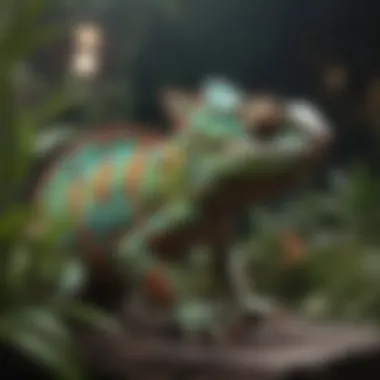Creating the Perfect Extra Large Chameleon Habitat


Intro
Designing an extra large enclosure for chameleons is a task that demands profound attention to detail. The natural complexity of these reptiles makes it crucial to provide them with a habitat that mirrors their wild environment as closely as possible. Creating such an enclosure entails understanding the species' biological needs and behavioral patterns. This comprehensive guide will explore essential elements, spanning from environmental conditions to materials and maintenance procedures. In this way, we can ensure that chameleons thrive in captivity, benefiting both the animals and their caretakers.
Fascinating Facts About the Animal
Unique Characteristics
Chameleons are known for their striking appearance and unique features. Their ability to change color is not merely for decoration; it serves to regulate body temperature and communicate with other chameleons. These reptiles possess a highly specialized tongue that can extend rapidly to capture insects from a distance. Their eyes are capable of moving independently, giving them a broad field of vision, crucial for spotting both prey and potential predators.
Extraordinary Abilities
Chameleons also exhibit extraordinary locomotion skills. They can climb with remarkable agility, using their zygodactylous feet to grip branches securely. Some chameleon species can even leap several times their body length when startled. This extraordinary adaptability is vital for their survival in the wild, as it allows them to navigate and hunt effectively in their natural habitats. Their ability to blend in with surroundings through color changes offers another level of defense against predators, showcasing their evolutionary finesse.
Behavior and Habitat
Natural Habitats
In the wild, chameleons inhabit diverse ecosystems such as rainforests, savannas, and deserts. Each species has its preferences, largely dependent on specific temperature and humidity levels. Understanding their natural environment is paramount in creating a suitable enclosure. Proper humidity control, temperature gradients, and ample vertical space are crucial for mimicking natural settings.
Social Structures
Chameleons are generally solitary creatures. They are territorial and often display aggressive behaviors when feeling threatened or challenged. This aspect must be considered when designing an enclosure to avoid conflict and stress among multiple chameleons. Each individual should have its own dedicated space with sufficient hiding spots to reduce interactions that may lead to stress.
Recent Scientific Discoveries
Latest Research Findings
Recent studies focus on chameleon biology, including their unique physiological adaptations. New findings suggest that chameleons possess advanced color-changing abilities that involve more than just pigments in their skin. Researchers are exploring these mechanisms to uncover the full range of their capabilities and how it impacts their interactions with fellow chameleons and their environment.
Breakthroughs in Animal Biology
Such breakthroughs in understanding chameleon biology also emphasize the importance of proper enclosure design. Insights into their physiological responses to different environmental stimuli can help optimize designs that enhance their well-being in captivity. This knowledge can lead to better habitat setups that reflect their natural conditions and improve their quality of life.
Cultural Significance
Animals in Folklore
Chameleons have made numerous appearances in folklore and cultural representations around the world. They symbolize change, adaptability, and transformation in various cultures. This cultural significance highlights the unique role chameleons play not only biologically but also symbolically.
Influence on Art and Literature
In art and literature, chameleons have been used as metaphors for change and flexibility. Their intriguing nature has inspired countless tales and artworks, underscoring their position in both natural history and human imagination.
Understanding these fascinating creatures and their environments enhances our approach to creating optimal living conditions within enclosures. With thoughtful design, we can support their health and well-being.
Intro to Chameleon Habitat Needs
Chameleons are unique reptiles that require specific environments to thrive in captivity. Understanding their habitat needs is critical to their well-being. This section focuses on the fundamental needs of chameleons, ensuring owners create suitable living spaces. Inadequate conditions can lead to stress and health issues, which emphasizes the need for proper enclosure design.
Understanding Chameleon Species
Chameleons exist in many species, each with distinct habitat requirements. For instance, the veiled chameleon prefers a hotter climate, while the panther chameleon requires different humidity levels. A thorough understanding of these differences is necessary when designing an enclosure.
Different species have unique behavioral traits as well. Some enjoy high vertical spaces for climbing, while others might prefer hidden, low spaces. Understanding these species differences aids in creating an effective habitat that meets their needs, supporting their natural behaviors and reducing stress during captivity.


Why Size Matters in Enclosure Design
When designing an enclosure, size significantly impacts chameleon health and behavior. An extra large enclosure allows chameleons to exhibit natural behaviors such as climbing, basking, and hiding. Smaller spaces can induce stress and hinder their ability to thrive.
A well-sized enclosure provides space for multiple temperature zones. Chameleons require a gradient of temperatures to maintain their health. An extra large enclosure provides suitable areas for basking, which enhances their ability to regulate their body temperature.
Moreover, larger enclosures support better air circulation and humidity control. This is vital for the well-being of chameleons. Inadequate airflow can lead to stagnant air and higher humidity levels than necessary, creating a breeding ground for harmful bacteria.
The importance of size cannot be overstated; a larger enclosure significantly improves the quality of life for chameleons in captivity.
In summary, understanding chameleon species and the importance of enclosure size forms the foundation for optimal enclosure design. This knowledge not only enhances the reptiles’ health but also enriches their lives, making them better companions for their owners.
Essential Requirements for Chameleon Enclosures
Creating a habitat that meets the essential requirements for chameleons is critical for their health and well-being. Any effort put into designing this environment directly impacts the chameleon's behavior, morphology, and longevity. This section will explore the considerations that must be taken into account, including how space, temperature, humidity, and light are vital for their survival in captivity.
Space Considerations and Dimensions
Chameleons require ample space to thrive. When considering dimensions for the enclosure, the general rule is to provide a minimum of 4 feet in height, as these reptiles are naturally arboreal. A height of 6 to 8 feet is preferable for larger species, encouraging their instinctual behavior to climb and explore. Horizontal space should not be neglected; a floor area of at least 2 feet by 3 feet is recommended to accommodate furniture like branches, plants, and basking spots.
Proper spacing allows for ambient air movement, which contributes positively to temperature regulation. Additionally, providing various levels in the enclosure ensures that chameleons can feel secure while also giving them options for basking and hiding.
Temperature and Humidity Control
An optimal temperature gradient is crucial for chameleons. The enclosure must include a basking area maintained between 85 to 95 °F, which allows them to metabolize food and regulate their body temperature. The cooler areas should range from 70 to 80 °F, creating a suitable habitat for nocturnal activity.
Humidity levels are equally important. A range of 40 to 70% humidity is necessary, depending on the species. Regular misting is required, as chameleons drink from the droplets forming on leaves instead of from standing water. Installing a hygrometer can assist in monitoring these levels, providing better control for the health of the animal.
Lighting Needs for Healthy Chameleons
Lighting plays a significant role in the chameleon’s overall health. UVB lighting is vital for the synthesis of vitamin D3, essential for calcium absorption. Without proper UVB exposure, chameleons can develop metabolic bone disease, a potentially fatal condition.
The enclosure should feature UVB lighting designed for reptiles, with a UVB output of 5-10% for 10 to 12 hours a day. This allows them to bask and regulates their circadian rhythms. Additionally, access to natural sunlight through a window can enhance their overall well-being, but care must be taken to avoid overheating.
A well-designed enclosure not only provides space but also ensures thermal and light conditions that mimic the chameleons' natural habitat.
In summary, meeting these essential requirements establishes a sustainable environment for chameleons, enabling them to exhibit their natural behaviors. As you design the enclosure, ensure these factors are kept in mind.
Materials for Construction
Choosing the right materials is fundamental in creating an optimal extra large chameleon enclosure. The materials used directly impact the safety, durability, and comfort of the environment. A well-constructed enclosure not only meets the physical needs of a chameleon but also enhances its overall quality of life. Proper materials can prevent issues like mold growth, temperature fluctuations, and escape attempts, all of which are vital for chameleon health.
Using materials that are non-toxic, sturdy, and easy to clean is crucial. It is also important to consider how the materials will interact with environmental controls such as humidity and temperature. The wrong choice can lead to various complications, affecting the well-being of these reptiles. Factors like ventilation, texture, and aesthetics play a role too. Choosing wisely ensures a habitat that is both functional and visually appealing, keeping both the chameleon and the owner satisfied.
Choosing Safe and Durable Materials
When constructing an enclosure, selecting safe and durable materials is non-negotiable. Glass and high-quality PVC are among the most common choices. These materials are easy to clean, resistant to humidity, and provide clear visibility of the enclosure's inhabitants. Glass enclosures, while heavier, offer excellent insulation and visibility. On the other hand, PVC is lightweight and often more affordable.
Considerations for material selection include:
- Non-toxic finishes: Ensure any paint, sealants, or finishes are free from harmful chemicals.
- Ventilation options: Using materials that allow for sufficient airflow helps maintain proper humidity levels.
- Structural integrity: Evaluate whether the chosen materials can support the weight of additional features like climbing branches or water systems.
Incorporating rugged metal for fixtures can ensure longevity in parts that face wear and tear. Regular checks for wear and damage intervene before problems escalate.
Incorporating Natural Elements
Integrating natural elements into the enclosure design is not just aesthetic; it is vital for the chameleon’s mental health and well-being. Elements like logs, branches, and living plants provide essential climbing opportunities and hiding spots for chameleons. They thrive in environments that mimic their natural habitats, allowing for more natural behaviors.


Using real plants enhances humidity levels and offers opportunities for natural foraging. Popular choices include:
- Ficus elastica: Known for its ability to thrive in varied lighting and humidity conditions.
- Pothos: Easy to maintain and helps improve air quality.
- Spider plants: Provides both shelter and visual interest in the habitat.
All materials must be checked for pesticides or harmful chemicals, ensuring they are safe for use in enclosures.
Furthermore, creating a visually complex environment helps stimulate the chameleon's senses, providing it with opportunities for exploration and engagement. Balancing aesthetic appeal and functional requirements is crucial to crafting a nurturing habitat. This careful approach provides a suitable space for the chameleon while also offering satisfaction to the caretaker.
Designing an Enclosure Layout
Designing an enclosure layout for chameleons is a critical aspect that directly impacts their health and behavior. An appropriate layout enhances the overall functionality of the space, providing the reptile with the necessary elements required for a thriving environment. As chameleons naturally inhabit diverse ecosystems, it is crucial to mimic their habitat in captivity. Creating an effective layout involves considering vertical and horizontal space usage alongside building climbing structures and hiding spots.
Vertical vs.
Horizontal Space Usage
Chameleons are arboreal creatures, meaning they spend a majority of their time in trees and high foliage. This natural behavior necessitates a thoughtful emphasis on vertical space in the enclosure. Verticality can be achieved by designing tall enclosures that allow for branching elements, such as vines or perches positioned at varying heights.
Effective vertical space usage offers multiple benefits:
- Encourages Natural Behaviors: By promoting climbing and exploring, chameleons engage in behaviors that keep them healthy and active.
- Improves Environmental Enrichment: Multiple levels create options for territorial display and visibility while reducing stress.
- Facilitates Temperature Gradient: Vertical designs allow for more effective temperature regulation as chameleons can bask at the top or seek cooler spots below.
While spatial height is often prioritized, horizontal space should not be overlooked. Designing a layout that balances both dimensions can optimize the chameleon's environment. Horizontal elements can also include essential features like water sources or basking areas that contribute to the animal's overall well-being.
Creating Hiding Spots and Climbing Structures
Integrating hiding spots and climbing structures into the enclosure layout is equally important. Chameleons are solitary animals that often seek refuge when feeling threatened or stressed. The presence of privacy spaces within the enclosure provides security and can minimize behavioral issues that arise from anxiety.
Consider the following when creating hiding spots:
- Natural Materials: Use logs, rocks, or dense foliage to create an authentic environment.
- Diverse Layouts: Design several areas where the chameleon can retreat, ensuring they are strategically placed throughout the enclosure.
Climbing structures are vital for their physical and mental stimulation. These structures need to be designed with the appropriate materials and shape. For example, consider the following features:
- Branching Vines: Strong and safe materials that allow the chameleon to grip and maneuver easily should be prioritized.
- Varied Width and Thickness: Incorporate a mix of different widths and textures to promote climbing and gripping behavior.
In sum, creating an enclosure layout that considers vertical and horizontal space, along with effective hiding spots and climbing structures, leads to a more enriched environment for chameleons. This approach ultimately supports their mental well-being and enhances their ability to thrive in captivity.
Creating a well-thought-out enclosure layout is fundamental for chameleons, as it closely mimics their natural habitat and encourages essential species-specific behaviors.
Maintaining the Enclosure
Maintaining the enclosure is critical in ensuring the health and happiness of chameleons. A well-maintained habitat not only supports the physical well-being of these reptiles but also enhances their behavioral traits. Poor enclosure upkeep can lead to various health issues, increased stress, and even premature death. An optimal living space is pivotal, considering that chameleons are sensitive creatures that respond dramatically to their surroundings.
Regular Cleaning and Maintenance Routines
Regular cleaning is a straightforward yet essential practice. Firstly, residue from uneaten food, feces, and shedding skin can accumulate. This waste can harbor bacteria and parasites, posing risks to chameleons' health. A good cleaning routine includes the following steps:
- Daily Spot Cleaning: Check for droppings and uneaten food. Remove them immediately to prevent odor and bacteria buildup.
- Weekly Cleaning: Deep clean surfaces, like branches and substrate. Remove any decorations and sanitize them with a mild antiseptic that's safe for reptiles. Rinse thoroughly afterward.
- Monthly Maintenance: Assess the entire enclosure. Replace any worn or damaged items. This also includes checking the structure for any mold or rot, especially in natural elements or wood.
By sticking to a systematic cleaning schedule, owners can create a sanitary environment that promotes healthy living. This makes for a happier chameleon.
Monitoring Environmental Conditions
Monitoring environmental conditions is another cornerstone of enclosure maintenance. Chameleons experience stress if temperature, humidity, or lighting varies from ideal ranges. Regular checks help to ensure that the enclosure remains within these vital parameters. This should include:
- Temperature Monitoring: Use thermometers placed in different enclosure zones. Chameleons enjoy a gradient that allows them to thermoregulate by moving between warmer and cooler areas.
- Humidity Levels: A hygrometer will show the humidity in the enclosure. Chameleons rely on specific humidity levels for hydration and shedding properly. Misting systems or water bowls can help maintain adequate humidity.
- Lighting Checks: Ensure that UVB lights are functioning correctly. These lights help in calcium absorption, which is crucial for bones and overall health.


Behavioral Enrichment in Extra Large Enclosures
Behavioral enrichment plays a crucial role in the well-being of chameleons housed in extra large enclosures. It involves creating an environment that stimulates their natural behaviors, which is important for both their physical health and mental wellness. Inadequate stimulation can lead to stress, which negatively impacts their immune system and overall health. By carefully considering how to incorporate elements of enrichment, owners can ensure that their chameleons thrive in captivity.
The Importance of Mental Stimulation
Chameleons are naturally curious creatures that engage in a variety of behaviors in the wild. They explore, climb, and hunt for food. Providing mental stimulation in an enclosure is essential to mimic these natural behaviors, allowing chameleons to express their instincts. Lack of mental engagement often results in boredom. This can lead to repetitive behaviors, such as pacing or hiding, which are signs of stress and can adversely affect their health.
In extra large enclosures, a diverse range of features can be introduced to promote mental stimulation. Items such as branches for climbing, varying leaf shapes, and movable structures can enrich their environment. This encourages exploration and play, which mitigates stress. Creating a dynamic habitat allows chameleons to interact with their surroundings, leading to a more fulfilling and active lifestyle.
Incorporating Interactive Features
Interactive features can significantly enhance the experience for chameleons in an extra large enclosure. Incorporating elements that challenge them can lead to more active behaviors. This can include features like:
- Feeders designed to simulate hunting: These encourage the chameleon to seek out food in more natural ways instead of simply finding it in a bowl.
- Water features: Dripping water or cascading water can not only provide hydration but also engage the chameleon in a hunting-like behavior.
- Visual barriers and tunnels: These structures can create a sense of security while offering places for exploration.
- Rotating decorations: Changing plants and structures can provide new challenges regularly.
Regularly updating the features in an enclosure engages chameleons and should be done periodically to keep the environment stimulating.
By utilizing these interactive features, owners can significantly promote active engagement and exploration. Features that challenge chameleons not only improve their mental health but also contribute to a healthier physical state by encouraging movement and natural activity. Each element introduced should be carefully monitored to ensure safety and functionality, thus creating an environment where the chameleon can feel at ease while being effectively stimulated.
Assessing the Benefits of Extra Large Enclosures
Assessing the benefits of extra large enclosures is vital for both chameleons and their owners. These spacious habitats not only allow chameleons to exhibit their natural behaviors but also positively impact their health and well-being. A thorough understanding of these benefits helps in making informed decisions about enclosure design.
Health Benefits for Chameleons
Extra large enclosures provide numerous health advantages for chameleons. Ample space encourages physical activity, which is crucial for muscle development and overall fitness. Congested environments often lead to stress, which can contribute to health issues. When chameleons have room to move around, it fosters a more active lifestyle, reducing the chances of obesity and related diseases.
Chameleons also benefit from improved social interactions when placed in larger enclosures. The more complex environment allows them to explore and establish territories. This can reduce aggression and competing behavior, leading to a more peaceful existence.
Moreover, having space allows for better environmental control. Owners can create diverse microhabitats within the enclosure, catering to the specific needs of their chameleons. This includes variations in temperature and humidity. When conditions are more aligned with the natural habitat of the chameleons, it promotes healthy skin shedding and proper digestion, crucial aspects of their overall well-being.
Quote: Maintaining a rich environment with suitable space directly correlates with the health and happiness of chameleons.
Enhanced Display for Owners
Extra large enclosures also enhance the display for owners. A spacious habitat provides a captivating view of the chameleons in their environment, allowing owners to appreciate their unique colors and behaviors. Larger enclosures allow for better arrangement of plants and decor, creating an aesthetically pleasing setup. This enhances the observer's experience and adds to the overall enjoyment of pet ownership.
Additionally, having an elaborate setup can become a point of discussion amongst friends and family. The intricate layouts may prompt questions about the species, care, and behavior. It fosters an environment for education about these reptiles, contributing to greater awareness and understanding.
Through the lens of display, these enclosures also serve as a testament to the owner's commitment to providing the best possible care. The effort put into creating an engaging habitat reflects in the chameleons themselves, as they thrive in such meticulously designed spaces.
Culmination: Crafting the Ideal Living Space for Chameleons
Designing an enclosure for chameleons goes beyond mere aesthetics. It is about creating an environment that supports their natural behaviors and well-being. In this article, we have highlighted essential elements necessary for an optimal extra-large chameleon enclosure.
Summarizing Key Points
Throughout this piece, we explored significant factors contributing to chameleons' health and happiness. Key points include:
- Understanding Species Needs: Different chameleon species have varied habitat requirements. Recognizing these needs ensures proper care.
- Space and Dimensions: An extra-large enclosure allows for movement and exploration, both crucial for their physical health.
- Temperature and Humidity: Climate control plays a vital role in mimicking a chameleon's natural habitat.
- Lighting: Proper lighting is essential for vitamin D synthesis, which supports their health.
- Materials: Choosing safe materials prevents harm and ensures longevity.
- Design Layout: Thoughtful layouts enhance climbing opportunities and provide hiding spots.
- Maintenance: Regular upkeep prevents illness and promotes a clean environment for the chameleons.
- Enrichment: Incorporating interactive elements stimulates their minds and encourages natural behaviors.
“An ideal habitat not only fulfills basic needs but also enriches the chameleon’s life.”
Encouraging Responsible Pet Ownership
Owning a chameleon is a significant commitment. Prospective owners must be aware of the responsibilities involved in establishing and maintaining a proper habitat. This includes continuous education on species-specific needs, regular monitoring of environmental conditions, and a keen awareness of their health.
Key considerations for responsible pet ownership include:
- Researching species-specific care requirements.
- Ensuring the enclosure is large enough for the chameleon's size.
- Regularly checking temperature and humidity levels.
- Providing a varied diet to meet their nutritional needs.
It is essential to foster a deep understanding of chameleons. By being informed and attentive, owners can provide an optimal environment that enhances their pet’s quality of life.







